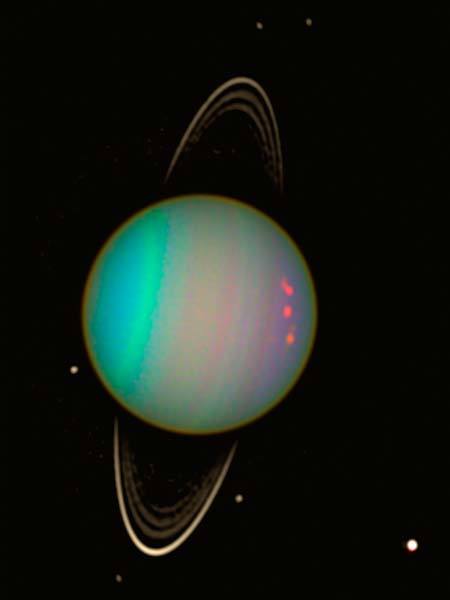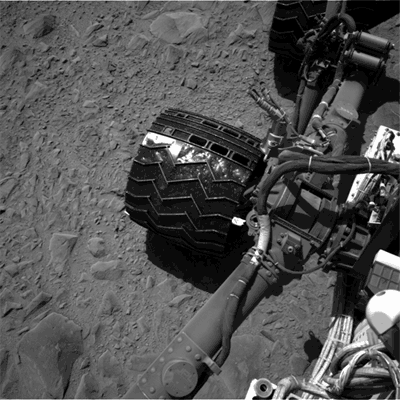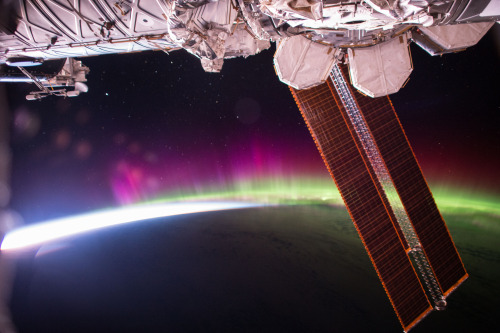Rings And Moons Circling Uranus, Taken By Hubble Space Telescope.

Rings and Moons Circling Uranus, taken by Hubble space telescope.
js
More Posts from Space-m17-blog and Others

A mini supernova

Rolling, rolling, rolling.
(via GIPHY)

A photo of S Rings, a ring near Saturn. Took by Cassini with COISS on October 02, 2008 at 18:38:16. Detail page on OPUS database.

http://angelwolf92.deviantart.com/

js

The Beauty of Earth

(3 June 1965) — Overall view of the Mission Control Center in Houston, Texas, during the early hours of the Gemini-Titan 4 spaceflight. Photo credit: NASA

Aurora from the ISS.
Photo credit: NASA

Pluto in Enhanced Color : Pluto is more colorful than we can see. Color data and images of our Solar System’s most famous dwarf planet, taken by the robotic New Horizons spacecraft during its flyby in July, have been digitally combined to give an enhanced view of this ancient world sporting an unexpectedly young surface. The featured enhanced color image is not only esthetically pretty but scientifically useful, making surface regions of differing chemical composition visually distinct. For example, the light-colored heart-shaped Tombaugh Regio on the lower right is clearly shown here to be divisible into two regions that are geologically different, with the leftmost lobe Sputnik Planum also appearing unusually smooth. New Horizons now continues on beyond Pluto, will continue to beam back more images and data, and will soon be directed to change course so that it can fly past asteroid 2014 MU69 in 2019 January. via NASA
js
Hot & Steamy RS-25 Engine Test

Today, we tested the RS-25 engine at Stennis Space Center in Mississippi, and boy was it hot! Besides the fact that it was a hot day, the 6,000 degree operating temperature of the hot fire test didn’t help things. This engine is one of four that will power the core stage of our Space Launch System (SLS) into deep space and to Mars. Today’s test reached 109% power and burned 150,000 gallons of liquid oxygen and 60,000 gallons of liquid hydrogen. When SLS launches with all 4 of its engines, it will be the most powerful rocket in the world!

This engine was previously used to to fly dozens of successful missions on the space shuttle, so you might be asking, “Why are we spending time testing it again if we already know it’s awesome?” Well, it’s actually really important that we test them specifically for use with SLS for a number of reasons, including the fact that we will be operating at 109% power, vs. the 104% power previously used.

If you missed the 535-second, ground rumbling test today – you’re in luck. We’ve compiled all the cool stuff (fire, steam & loud noises) into a recap video. Check it out here:
-
 agir1ukn0w liked this · 1 month ago
agir1ukn0w liked this · 1 month ago -
 cultural-derealization reblogged this · 5 months ago
cultural-derealization reblogged this · 5 months ago -
 thepantyraids reblogged this · 10 months ago
thepantyraids reblogged this · 10 months ago -
 thepantyraids liked this · 10 months ago
thepantyraids liked this · 10 months ago -
 unconstricted-style reblogged this · 10 months ago
unconstricted-style reblogged this · 10 months ago -
 shesdemure reblogged this · 10 months ago
shesdemure reblogged this · 10 months ago -
 flaviiiiah reblogged this · 1 year ago
flaviiiiah reblogged this · 1 year ago -
 flaviiiiah liked this · 1 year ago
flaviiiiah liked this · 1 year ago -
 xtimoleon liked this · 1 year ago
xtimoleon liked this · 1 year ago -
 untiltled818 liked this · 1 year ago
untiltled818 liked this · 1 year ago -
 whisperingspirit liked this · 1 year ago
whisperingspirit liked this · 1 year ago -
 beezus--bieber reblogged this · 1 year ago
beezus--bieber reblogged this · 1 year ago -
 iganimedes liked this · 2 years ago
iganimedes liked this · 2 years ago -
 angryblondewithajetblackheart liked this · 2 years ago
angryblondewithajetblackheart liked this · 2 years ago -
 nitrodose reblogged this · 2 years ago
nitrodose reblogged this · 2 years ago -
 nitrodose liked this · 2 years ago
nitrodose liked this · 2 years ago -
 merridelicious liked this · 2 years ago
merridelicious liked this · 2 years ago -
 marysmirages liked this · 2 years ago
marysmirages liked this · 2 years ago -
 marivela14 liked this · 2 years ago
marivela14 liked this · 2 years ago -
 louwitcher reblogged this · 2 years ago
louwitcher reblogged this · 2 years ago -
 louwitcher liked this · 2 years ago
louwitcher liked this · 2 years ago -
 pikxii reblogged this · 2 years ago
pikxii reblogged this · 2 years ago -
 712220 reblogged this · 2 years ago
712220 reblogged this · 2 years ago -
 virginlibertine reblogged this · 3 years ago
virginlibertine reblogged this · 3 years ago -
 virginlibertine liked this · 3 years ago
virginlibertine liked this · 3 years ago -
 redlore liked this · 3 years ago
redlore liked this · 3 years ago -
 animasmagic reblogged this · 3 years ago
animasmagic reblogged this · 3 years ago -
 heavenlyrosess reblogged this · 3 years ago
heavenlyrosess reblogged this · 3 years ago -
 prettyyk-tty reblogged this · 3 years ago
prettyyk-tty reblogged this · 3 years ago -
 yougoththis reblogged this · 3 years ago
yougoththis reblogged this · 3 years ago -
 fluxface liked this · 3 years ago
fluxface liked this · 3 years ago -
 vvarhound reblogged this · 3 years ago
vvarhound reblogged this · 3 years ago -
 cosmicjokesblog liked this · 3 years ago
cosmicjokesblog liked this · 3 years ago -
 ayyoade reblogged this · 3 years ago
ayyoade reblogged this · 3 years ago -
 arrcaneee reblogged this · 3 years ago
arrcaneee reblogged this · 3 years ago -
 vohugaona reblogged this · 3 years ago
vohugaona reblogged this · 3 years ago
I love space. I've been to space camp in Huntsville Alabama and I am planning on going every summer. I look forward to be an astronaut for nasa on the sls that is planned to be launched 2018. And the manned mission 2030. So yeah I won't let anything get in my way.
138 posts